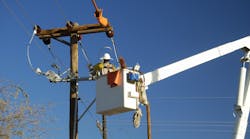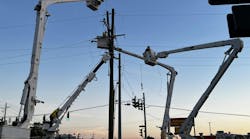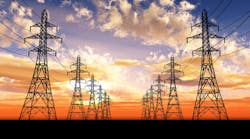One of the U.S.’s worst power outages in history happened on a balmy Thursday in August. The "Northeast Blackout of 2003 was a massive power outage that affected a vast portion of the northeastern United States and parts of Canada and left approximately 50 million people without electricity.
The blackout was triggered by a series of events that cascaded into a widespread power failure. It started in Ohio, where high-voltage power lines sagged just low enough to reach the overgrown trees below. This contact tripped the lines causing them to go offline and resulting in a significant drop in power supply to the region. With several lines down, the sudden decrease in power created an imbalance in the interconnected power grid system, triggering a domino effect.
Since the blackout, which put many communities at risk, authorities, utilities, and regulators have continuously worked to implement safety standards, protocols, and technologies to ensure the reliability and safety of electrical power lines. But such work is challenging. It requires technicians and engineers to work with sensitive equipment at dangerous heights making electrical repairs one of the deadliest occupations in America.
With new technologies, this is starting to change. The industry at large is seeing a revolution in how it repairs power lines—the kind of rapid progress that hasn’t happened since the immediate aftermath of the Northeast Blackout.
Here’s how technology is making power line inspection and repair safer tomorrow, today.
The Dangers of and Issues Facing Electrical Power Line Repair
Power Line Repairs have been consistently ranked among the top 20 most dangerous jobs in the United States, with 24.2 deaths per 100,000 workers in 2021 according to the U.S. Bureau of Labor Statistics.
The industry faces a critical talent challenge with an aging workforce that will soon retire, creating the threat of a technician shortage that needs immediate attention. 50% of the utility’s workforce is set to retire over the next decade.
Furthermore, adhering to OSHA's regulations and ensuring OSHA-compliant inspections is essential to maintaining safety standards. And the list of regulations is long and complicated. This does ensure safety standards are met, preventing further injury and loss of life, however, it also impedes rapid progress and innovation.
Technology has to go hand in hand with regulations because what is currently being done to mitigate risks isn’t enough. Switching from human to technology-powered inspections is an efficient way to go and allows for remote monitoring.
Here are three buckets of technological advancement that can make power line repair safer AND enable better decision-making:
1. Proactive Safety
To dramatically improve safety in the electrical power line repair industry, a shift towards proactive safety measures is essential. Technology plays a vital role in minimizing the risks technicians face during regular inspections.
AI image processing and anomaly detection can remotely review power lines, reducing the need for technicians to be physically present near hazardous areas. This shift minimizes the chances of potential injuries, keeping technicians largely out of harm's way.
Moreover, early detection of maintenance issues through predictive analytics and AI can prevent minor damages from escalating into larger safety hazards. For instance, detecting damaged or faulty components in power lines early can prevent the occurrence of devastating events such as wildfires, protecting both the environment and public safety.
By reducing the need for human inspections, technology enables maintenance trips to be conducted on an as-needed basis, minimizing unnecessary exposure to risk. This approach not only ensures safer working conditions but also increases operational efficiency and cost-effectiveness.
2. Eliminating Helicopters and Adopting Drones
Replacing helicopters with drones for power line inspections is a game-changer in enhancing safety and cost-effectiveness. Helicopters are expensive to operate, with costs amounting to approximately $2 million per year.
In contrast, drones present a significantly cheaper alternative, with operating costs as low as $250,000 per year. This cost reduction allows companies to allocate resources to other essential aspects of their operations, including safety training and equipment.
The maneuverability of helicopters around power lines is challenging, putting pilots and passengers at risk. In contrast, drones are lighter, more compact, and capable of navigating through tighter spaces, reducing the chances of collision with power lines.
Drones offer enhanced safety benefits as they eliminate the risk to human pilots and passengers. In the event of a crash, drones cause minimal damage compared to traditional helicopters or fixed-wing aircraft. Moreover, drones are designed to find the safest place to land, even in emergencies, minimizing additional harm.
Upskilling the existing workforce to become drone pilots presents an opportunity for industry and employee retention. By providing training for current employees to operate drones, companies can retain valuable expertise and experience within the workforce while modernizing their inspection methods.
Thankfully, The Federal Aviation Administration (FAA) has been granting Beyond Visual Line of Sight (BVLOS) waivers to drones for utility inspections, demonstrating the industry's recognition of the safety and efficiency advantages they offer.
3. Improving Emergency Response
Technology facilitates rapid and efficient emergency response in the electrical power line repair industry. During natural disasters, such as storms and hurricanes, power lines are often severely damaged, leading to live wires and hazardous conditions. Traditionally, technicians would have to manually inspect the damage, putting their lives at risk.
However, with technology, technicians can assess the damage remotely and develop a predetermined course of action, reducing the need to send personnel into potentially dangerous environments. This approach allows for repair and rehabilitation efforts to move forward without jeopardizing the safety of the technicians.
A Safer Tomorrow
The electrical power line repair industry has long been recognized as one of America's most dangerous jobs, but with the integration of technology, the future is brighter.
Not only can utilities proactively screen issues before they happen using AI image processing and predictive analytics tools, but they can react faster when they do using drones, to vastly improve our emergency response. This will protect the lives of technicians while also deploying them more efficiently, something that will be much needed as the workforce ages and retires.
These technologies will make a safer tomorrow, while also mitigating major crises, so, hopefully, events like the Northeast Blackout of 2003 can stay in the past.
Vik Chaudry is CTO, COO and co-founder of Buzz Solutions.


